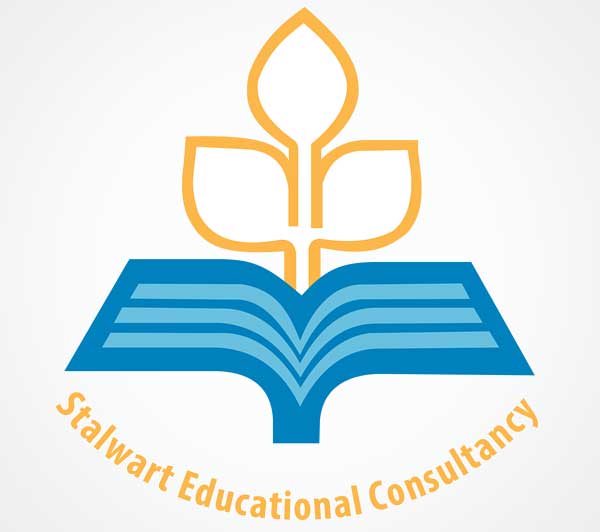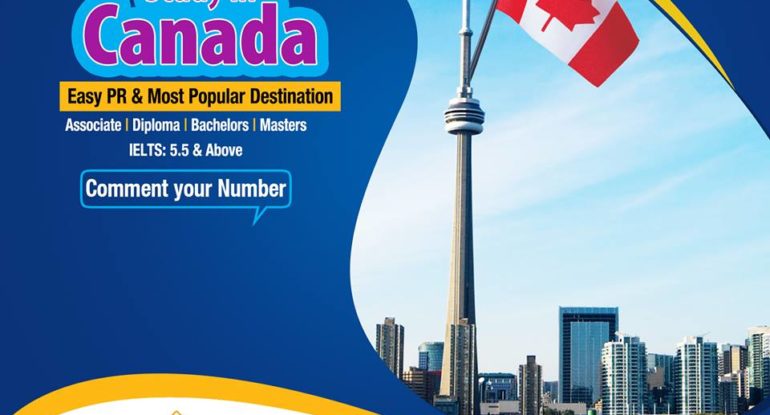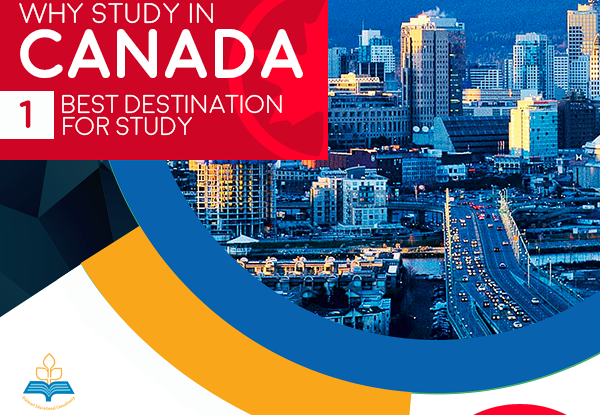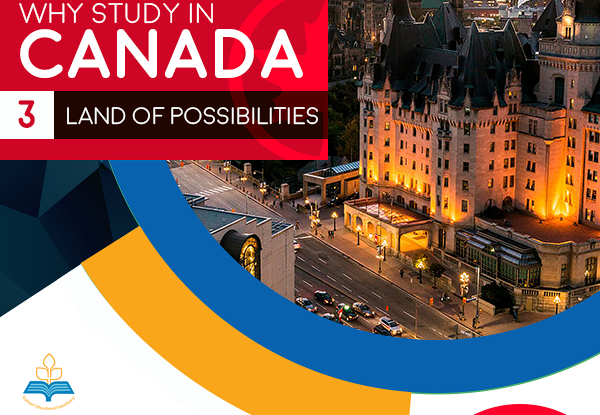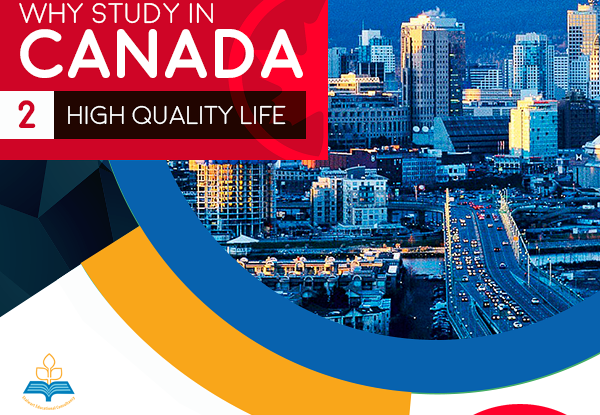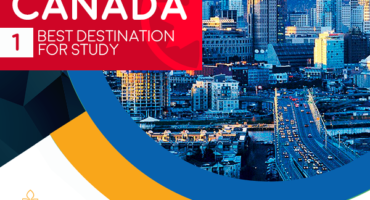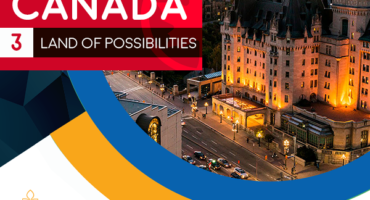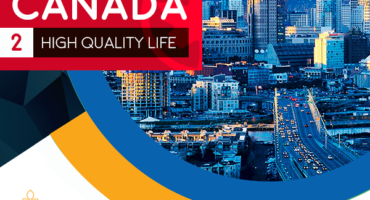Canada
Study in Canada
Canada is one of the greenest countries, not just in terms of the forest cover but also in terms of the awareness and attitude of the people towards the environmental cause. The average Canadian values protection of the natural environment fairly well. There are over 40 national parks and several UNESCO World Heritage sites spread over different provinces. The country offers a soothing environment full of forest covers, natural lakes, mountains and green pastures.
Canada is known for its peaceful social environment and safety of the citizens. University authorities take utmost care to ensure safety of international students on campus, and International Student Offices offer valuable advice regarding personal and property safety issues and social code of conduct.
Another major attraction for Indian students to study in Canada is the fact that Canada today is taking great leaps forward in the realm of technology, a field where the expertise of Indians is well recognized. Scientists, engineers and innovators in both academia and industry perform cutting edge technology to make Canada a knowledge based society. Indians have contributed to evolution both in terms of research, innovation and entrepreneurship. Professionals with Canadian qualifications get distinctive advantage while seeking skill based immigration. Thus, moving to Canada for higher education is a wise decision for your career and life!
Education
Just as the country is diverse in terms of culture, race and religion, the education system also thrives on diversity of opportunities for studying. While maintaining high quality both in knowledge creation and dissemination, Canadian education system offers study opportunities ranging from short term courses of a few months to doctoral level education. Though individual states have jurisdictions over education in their own territories, the country as a whole has national commitment towards quality of education, and institutions get generous federal funding. Canada today is home to several world class universities with the University of Alberta, University of British Columbia, McGill and McMaster ranked in the top 150 universities in the world.
Largely, the educational institutions offering post senior secondary courses can be divided into four categories:
- Technical and Career Colleges
- Community Colleges
- University Colleges
- Research Universities
Students can pick from any of these types of institutions to pursue the programs of their choices, which range from post senior secondary certificates to diploma and from Bachelor’s degree to doctorate. Students also have the choice to opt from urban and semi urban campuses depending on personal preference. The universities and local students generally are very welcoming towards international students as it is the international student community that contributes to the vibrancy of the society and evolution of an innovative system in the country. International students integrate into the local culture through participation in different clubs and societies and at times through part time work.
Popular streams of study
Canadian universities offer courses on almost every academic discipline. However, when it comes to international students, there are some courses that are in demand. Given below is a brief account about these streams and also the job prospects after the course:
Business
- Administrative Support
- Office Manager
- Accounting Manager
- Executive Assistant
- Marketing Director
- Project Manager
Information Technology
- Network Specialist
- Software Developer
- Technician
- Systems Administrator
Hospitality and Tourism
- Restaurant Managers
- Resort/Club Managers
- Food service managers
- Catering executives
Health Sciences
- Home support Agencies
- Crisis Centre
- Club Houses
- Residential facilities
Canada is a well-educated nation at the post-secondary level. The proportion of Canadians aged 25 to 64 with a post-secondary degree or diploma is 53%, the highest in the OECD. Graduate degrees from Canadian universities, including masters and doctoral degrees, are highly regarded internationally and generally offer competitive tuition fees.
University and college semesters generally run as follows:
- First semester: early September to mid-December
- Holiday break: mid-December to early January
- Second semester: early January to early May
- Summer holidays/Summer courses: May to September

What Is a Study Pathway?
A study pathway is the study plan the student will follow—as it relates to the institution(s) and degree(s), diploma(s), and certificate(s) they will use to gain the credentials and experience required for their desired career.
A study pathway could include only one institution, degree and/or program, or it could include more than one, depending on the student’s ultimate goal and situation and what the institution(s) offer.
Traditionally, students wanting full degrees in Canada have begun their post-secondary studies at universities with undergraduate degrees—bachelor’s—that generally require three to four years when undertaken on a full-time basis. They could then choose, either immediately upon successful completion of their “undergrad” degree or after working for a period of time, to progress to graduate degrees—master’s and possibly then the highest level, doctoral—or to degrees in law or medicine (both of which require some level of prior undergraduate study), with admission contingent on high enough grades and/or other program-specific criteria.
While this traditional model is still followed by many students in Canada, there are now other study pathways and programs to choose from as a result of Canada’s quick adaptation to the changing skills demanded by a globalized, increasingly sophisticated labor market. For example:
- Certain colleges offer undergraduate degrees as well as practical degrees or diplomas.
- It is now quite common for students to begin an undergraduate degree at a college, polytechnic institution and then finish it at a university depending on their program of interest (please see text box on University Transfer Programs).
- After graduating from a university program, it is becoming more common for students to complement their university degree by pursuing a separate college degree or diploma.
While at first glance, this may sound confusing, there’s a better way of looking at it: there is now a great deal of flexibility within the Canadian post-secondary system, with colleges, polytechnics, and universities increasingly cooperating to give students the exact education they need for their chosen careers. Students can compose their own education, for example:
- They could choose simply to take a full degree from one institution (college, polytechnic, or university).
- They could choose to start their degree at one institution and then finish it at another (again, please see University Transfer Programs).
- They could complete a full degree at one institution then add on to it with a diploma or certificate from another institution designed to give them more specific and/or practical skills.
- They could choose to take a diploma or certificate (or several, depending on the skills they wanted and requirements of their desired job) rather than a degree.
Program searches should therefore include a broad range of institutions to ensure all possibilities are covered. It will be important to speak with specific institutions of interest to see what kind of study pathways are available to the student as they relate to the program of interest (e.g., opportunities for joint programs, co-operative education, internships, etc.) Co-operative education, or “co-op,” allows students to gain academic credit for hands-on work experience related to their program of study.
When conducting a program search, refer to the searchable database of Canadian study programs available on the EduCanada website.
University Transfer Programs
Many colleges and polytechnics have agreements with universities whereby certain courses are transferable and will be recognized by the university as counting toward a university degree.
These transfer programs are increasingly popular because they allow students to take the first one or two years of a typical four-year university degree at a college, before transferring to complete the final two years of the degree at university.
Why would a student want to do that? Colleges often offer smaller class sizes, greater access to instructors, competitive tuition fees, and a more personal atmosphere. This is very important for international students—many international students find beginning studies at a college to be a very comfortable, supportive option before they move on to a university, if a university degree is their goal. This way, they get the best of both worlds—the benefits of a college education and a university education.
University transfer programs across Canada include Business, Commerce, Journalism, Arts, Education, Engineering, Science, and Computer Science … and many more.
There are also some colleges and universities that offer joint diplomas and degrees, including agreements with other international institutions. The only way for agents to know about such arrangements is to find out directly from the institution/program, once they are very familiar with a college or university’s offerings.
Five Essential Points to study in Canada
- Canadian universities are globally competitive, have a strong record of research excellence, and offer high quality education. From coast to coast, they share a common culture of quality and excellence, and a commitment to ensuring that high standards are achieved and maintained in their academic programs. As a result, a Canadian university degree is locally and globally recognized for its quality.
- Close to 15,000 undergraduate and graduate degree programs are offered by roughly 100 institutions nationwide. Canadian universities offer excellent value for money across a wide range of programs and disciplines that provide students with invaluable hands-on experiences, including co-op placements and internships. Canada’s globally minded campuses offer students invaluable critical thinking and analytical skills required in today’s global economy.
- International students can expect to be assisted in their university studies by resources and services, such as orientation sessions, support programs, academic advising, prayer rooms, safe walk programs, student clubs, and assistance with medical concerns or housing issues.
- International students can often work while they study, taking advantage of many cooperative education and internship opportunities. There are also immigration programs that international students may qualify for post-graduation.
- Canada’s system of university quality assurance is multi-layered, comprehensive, and rigorous, ensuring high-quality education across all Canadian universities.
Understanding the Options
Though higher education in Canada is decentralized and falls under the jurisdiction of the country’s ten provinces and three territories, Canadian universities have a robust and comprehensive quality assurance system. Each Canadian university determines its own quality assurance standards and procedures, but it is also committed to a common framework of quality standards across all Canadian provinces. This means that Canadian universities have a shared understanding of the value of one another’s academic credentials and that their high quality standards are recognized internationally.
Canada offers a variety of university settings, depending on the student’s personality and interests. If the student is looking for a campus with large research facilities in a buzzing urban center, it’s here. If they prefer a small liberal arts institution in a quiet rural setting, this is also an option. Canada also has medium-sized comprehensive institutions that will range from about 1,000 to 25,000 students—these types of universities are located in a variety of urban centres such as Halifax, Sherbrooke, Kingston, Peterborough, Thunder Bay, Saskatoon, and Victoria.
Canada’s universities grant a full range of degree, from three- to four-year bachelor’s degrees, to master’s degrees and doctorates (PhD). Other options include professional degrees in medicine, law, architecture, and dentistry to name a few, as well as certificates, diplomas, and shorter career-focused programs.
Many universities offer full-time and part-time enrollment options as well as co-operative education, distance learning, and continuing education.
Programs are offered in English or French; some institutions offer instruction in both official languages. Some offer French studies in English cities—there are 14 Francophone universities in provinces other than Quebec—and some offer English studies in French cities. Regardless of the language of instruction, some programs or institutions allow students to hand in work and/or write their exams in the official language of their choice.
There is online and distance education in Canada: International students who want a Canadian education but cannot, for whatever reason, study abroad, may be very interested in online learning. Canadian Virtual University (CVU) is an association of Canada’s leading universities specializing in online and distance education. Students can earn a Canadian degree without ever attending a physical campus: there are over 400 programs and more than 2,500 courses, searchable from a single website: www.cvu-uvc.ca/english.html. This website hosts a section specific to international students and a FAQs page (Frequently Asked Questions).
Graduate Studies and Research in Canada
There are three types of graduate degrees:
- Course-based master’s degree: This requires successful completion of specific graduate-level courses and is typically one or two years in duration.
- Research-based master’s degree: Requires completion of both graduate-level courses and a thesis and is typically two years in duration. Graduate students usually choose a thesis topic in consultation with a graduate supervisor, although many universities require a statement of research interests as part of the application process.
- Doctorate or PhD degree: Requires completion of original research and defense of a thesis that makes a substantial contribution to the chosen field of study and is typically at least four years in duration.
When students pursue their research goals in Canada, they become valued members of a community that is internationally recognized for research excellence and enjoys a long-standing tradition of delivering on discovery. Canada supports researchers through such prestigious programs as the Canada Research Chairs, Canada Excellence Research Chairs, and Vanier and Banting scholarships.
Canadian universities spin off research-based companies at a truly impressive rate. Canada is home to life-changing innovations like insulin, the electron microscope, the cardiac pacemaker, and the Canadarm used in space exploration.
International students pursuing post-graduate studies in Canada are also eligible for the Post-Graduation Work Program, designed to provide graduating students with Canadian work experience in their fields of study.
Financial Assistance
Canada is among the most affordable of the leading study abroad destinations, and there are a number of scholarship and award programs at the undergraduate and graduate levels to assist international students. This financial aid is awarded based on criteria such as academic success, community involvement, athletic excellence, references from instructors and employers, or purely financial need.
Quality Assurance
While there is no national accreditation body for universities in Canada, provincial legislation and universities’ membership in Universities Canada ensure that universities maintain the high standards that allow Canadian degrees and other credentials to be recognized and respected across the world.
Membership in Universities Canada is granted through a rigorous process of peer review. Institutions must demonstrate adherence to all Universities Canada membership criteria, which include:
- Good governance and administrative structure;
- Highly qualified faculty with PhDs;
- Minimum enrolment of 500 full-time students;
- Academic programs of university standard;
- Access to library and other learning resources appropriate to the institution’s mission, goals and programs;
- Robust quality assurance policy;
- Respect for academic freedom, intellectual integrity, and intellectual property;
- A not-for-profit basis of operations.
Did You Know?
The variety of programs offered by Canadian universities is astounding. Here are just some examples from the thousands offered across Canadian universities:
- Bachelor of Business Administration
- Bachelor of Journalism
- Bachelor of Medical Imaging
- Bachelor of Science in Applied Plant and Soil Sciences
- Bachelor of Science in Nutrition
- Bachelor of Science in Computer Science
- Bachelor of Science in Neuroscience and Mental Health
- Bachelor of Science in Pharmacy
- Certificate in Special Education
- Certificate in Business Fundamentals
- Fashion Design Diploma
- Master of International Affairs
- Master of Natural Resources and Environmental Sciences
- Master of Fine Arts in Creative Writing
- Doctor of Dental Medicine in Dentistry
- PhD in Medical Genetics
- Speech and Language Assistant Diploma
Learning in Canadian Universities
International students will naturally feel both excited about studying in a different culture and education system and worried about fitting in and succeeding.
Attendance
Attendance is important in Canada; students do not simply receive their grades based on one final exam. Attendance is seen as an indication of commitment from the student.
Participation
In many countries, students receive a passive, rather than active, orientation toward learning, in which they are expected to simply listen and receive information. But in Canada, questioning and critical thinking are expected at the post-secondary level; students are encouraged to speak out in class and/or volunteer answers.
Lower Level of Formality
Most international students are surprised by the “informal” relationship between instructors and students in Canadian educational institutions. It may take some time before they feel comfortable asking questions or offering an opinion. They may initially be embarrassed or unsettled by direct communication with instructors. Instructors are definitely the experts in the classroom, but they are open to receiving feedback and encouraging discussion among students.
Evaluation
The process of evaluation at university/college is often new to students from other countries. They may be accustomed to being graded on the basis of one final exam and are unused to progressive evaluation throughout the term. They may not be aware that attendance, participation, projects, and small quizzes can contribute to a cumulative grade.
Individual and Group Work
The distinction we make in Canada between individual and group work is not always shared by other cultures. In Canada, individual work is expected to be original and not the result of a group of friends doing the work together and each submitting the same content. With group work, students are expected to fully participate; this is why language support is important for international students: it helps them be more confident in engaging in group situations.Academic Honesty
The meaning of academic honesty is difficult for many students to fully grasp. The concept of plagiarism may be new for many international students who may never have been required or taught to properly cite sources. In some educational environments, information is a public commodity; ownership of ideas is not recognized in the same way it is here. In addition, in many cultures it is preferable to quote the “expert” rather than to paraphrase in one’s own words.
From (with minor modifications) TRU: A Globally Minded Campus, available on the TRU World website
Costs of Study
The following tables provide different ways for the student.
Of course tuition is not the only cost international students will need to budget for when studying in Canada; they must also factor in the cost of living. Figure looks at the average cost of an undergraduate degree, including the cost of living, across leading study abroad destinations including Canada:

Source: HSBC “The Value of Education: Springboard for success,” September 2014
Scholarships
There are many programs and funding options for international students interested in studying in Canada: particularly international students of high academic standing or, in some cases, qualified students from certain areas or countries for whom scholarships or other financial assistance is in place.
The first place to look for information is the Canadian government’s international scholarships page. This online resource allows students to look up available scholarships based on their country of origin. Increasingly, Canadian provinces and territories are developing their own scholarship and award programs for international students.
There are two main ways of conducting a search to see if the international student may be eligible for a scholarship or other funding:
By institution:
By available government funding
Home Country Scholarships
The Libyan-North American Scholarship Program (LNASP)
The Canadian Francophonie Scholarship Program (CFSP): The Canada Francophonie Scholarship Program is a scholarship program designed to strengthen institutional capacities through the training of nationals of 37 developing countries members of La Francophonie and beneficiaries of Canada’s official development assistance.
Funding for this program rests entirely with the Government of Canada, which has entrusted it to the Canadian Bureau for International Education (CBIE) consortium and World University Service of Canada (WUSC) since January 1, 2015.
Bolashak International Scholarships Program (Kazakhstan): Bolashak International Scholarship was established on November 5, 1993, by President Nazarbayev to help train highly-qualified professionals capable to conduct reforms and represent the country at the international arena.
Graduate Scholarships
There is significant funding/financial assistance available for international students of high academic standing at the Canadian graduate level (e.g., master’s, PhD, post-doctoral). This assistance may be in the form of:
- Teaching/departmental assistantships;
- Research funds;
- University graduate scholarships;
- External scholarships (i.e., scholarships provided by a third party);
- Bursaries (awards based on financial need that are intended to supplement a student’s other funding sources).
The value of these awards will vary significantly by academic department as well as institution. For more information, agents should contact the institutions under consideration by the international student.
Did You Know?
International Experience Canada (IEC) is a travel and work abroad initiative of Immigration, Refugees and Citizenship Canada (IRCC). It is enabled by the fact that bilateral youth mobility arrangements and agreements with different countries around the world allow Canadians and non-Canadians to travel and work in each other’s countries for up to one year.
Youth aged 18–35 from countries where an arrangement or agreement exists may apply to the IEC program.
Understanding the Options
Canadian colleges and institutes deliver a broad range of applied, hands-on, and practical education. These institutions of practical learning are variably called colleges, institutes of technology, polytechnics, regional colleges, centres, colleges of applied arts and technology, community colleges, institutes, or Collège d’enseignement général et professionnel (Cégep in Quebec).
Such institutions work hand-in-hand with industry to ensure that students are prepared and ready to take advantage of current and emerging job market opportunities and secure key roles in industry, whether in Canada, North America, or abroad. Graduates are leaders in industry the world over. Their sought-after skills and education are transferable and globally recognized.
Colleges and institutes take advantage of their strong linkages with the private sector to develop state-of-the-art applied research programs. These programs are an important part of the Canadian innovation system, equipping graduates with the skills and experience needed to address some of the key challenges in today’s globalized society.
These institutions offer a wide range of credentials, including bachelor’s degrees, diplomas, apprenticeships, certificates, graduate offerings, continuing education and corporate training, any of which may include a co-op and/or an internship. For example:
- One-year post-graduate professional certificates of specialization
- Two- or three-year diplomas in technology or business
- Four-year applied bachelor degrees with internships
- English and/or French language studies
- Four-year combined institute and university degrees
There are 135 colleges/institutes in Canada with over 1,000 college campuses within a range of settings—from urban centres to remote communities. Programs are offered in French, English, or both depending on the region. Many also offer combined distance-learning opportunities.
Over 8,000 programs with varying lengths of required study are offered nationwide. Shorter two- to three-year diploma programs train technicians, technologists, mid-level managers, and service providers. There are also one-year post-graduate certificates available to Canadian and international university graduates who wish to acquire applied and advanced skills for specific areas of employment.
Examples of post-graduate programs with specialized focus on current industry practices leading to high employability of graduates:
- Global Business Management
- Renewable Energy
- Entrepreneurship
- Electronic Game Design
- Health Information Management
Three- to four-year bachelor’s degrees provide job-focused education in a variety of fields. Examples of bachelor degrees with an applied focus in a particular field include:
- Bachelor of Applied Technology in Industrial Design
- Bachelor of Applied Business in E-Commerce
- Bachelor of Arts in Criminal Justice
- Bachelor of Applied Information Systems Technology
The college/institute school year is the same as other post-graduate calendars, running from September through April or May, with spring and summer courses often available. Some institutions have a semester or trimester system allowing students to begin programs in September, January, or May. Quebec Cégeps offer two streams of education: three-year vocational and two-year pre-university programs.
Canadian college credentials are approved by provincial or territorial governments. Programs may also be accredited by independent industry or professional employer organizations. To ensure rigorous academic quality, the provincial ministries of education determine which institutions are allowed to offer bachelor’s and applied degrees.
Why Would International Students Choose a College or Institute?
Colleges and institutes work closely with industry to ensure courses reflect the skill requirements that employers need. They will provide practical training and many encourage work experience through supervised apprenticeships, work placements, and internships. This hands-on training ensures students move beyond academic learning to apply and test their skills in real workplace settings.
Colleges and institutes offer a vast range of programs in Information Communications and Technology (ICT)-related fields, from certificates, diplomas, and degrees to graduate certificates. They train ICT
Technicians, technologists, and practitioners. They are also leaders in the delivery of e-learning technology and curriculum.
Most colleges and institutes across Canada involve students in applied research projects conducted with local businesses. This enriched learning experience exposes students to real-world challenges and new technologies and establishes key contacts within industry for potential job opportunities.
Some colleges offer transfer programs that enable participants to complete courses through the college and then later transfer into a university or university college, with credit toward their university degrees. Thus colleges can either be the full educational experience for an international student, or a part, if the student wants both college and university education. Under a university transfer arrangement, the student would typically do one or two years at a college and then two years at a university. The benefits to the international student of such a transfer arrangement are:
- Smaller classes at the beginning (during the college portion of the study program), with more support;
- A more applied and practical study program than university alone, with opportunities for placements with industry while at college;
- A lower cost than university alone.
In addition, a relatively recent phenomenon highlighting the strength of Canada’s demand-driven, applied learning system is university graduates complementing their baccalaureate degrees with a college/institute diploma or certificate. In the last five years, Ontario alone has seen a 40% increase in university graduates enrolled in their colleges, often for one-year post-graduate certificates of specialization, with internships.
Applying for a Study Permit
Prospective students must apply for a study permit if their main reason for coming to Canada is to study. Generally, students must apply for a study permit before coming to Canada, and must have been accepted at a school, university, or college in Canada before applying.
Student Resources
The Citizenship and Immigration Canada website provides the information and application forms a student will need to get a study permit.
In particular, the “Get study permit” section provides detailed information on the following:
Preparing to study
- What is needed before applying for a study permit in Canada;
- How to determine eligibility;
- Who can apply and what exceptions exist;
- Which documents are needed before applying for a study permit.
Applying for a study permit
- How to apply and what documents to provide with an application;
- How to download the application package;
- How to pay application fees and submit an application;
- How to check processing times;
- How to determine how many days it will take to process an application once the complete application package has been received.
After applying
- What an individual should do after they apply for a study permit;
- How to check an application’s status;
- How to prepare for arrival;
- What to expect upon arrival in Canada.
Visa Application Centres
In some countries, students may have the option to visit a visa application centre (VAC). These centres provide administrative support services to help applicants submit their applications. This service is particularly useful in countries or regions where there are few or no visa offices.
What VACs do:
- Answer questions in local languages and make sure that applications are complete;
- transmit application documents and passports to the visa office securely;
- Return passport and decision documents securely;
- Offer a tracking service;
- Schedule interviews and provide application photographs and photocopies for a fee;
- Provide access to a computer to apply online;
- Collect biometrics (fingerprints and photograph).
What VACs do not do:
VACs play no role in the decision-making process and are expressly forbidden to provide any visa-related advice to applicants. All decisions on applications are made by visa officers at the visa office.
- VACs do not represent the Government of Canada (GoC). VACs are managed by private companies or international organizations and are authorized to provide specific services to applicants under the terms of a formal agreement with Citizenship and Immigration Canada.
The use of VAC services is completely optional. Applicants can continue to apply directly to the appropriate visa office, if they prefer.
Electronic Travel Authority (eTA)
Visa-exempt foreign nationals who fly to or transit through Canada need an Electronic Travel Authorization (eTA). Exceptions include U.S. citizens and travellers with a valid Canadian visa. Canadian citizens, including dual citizens, and Canadian permanent residents cannot apply for an eTA.
Study permits for minors
In Canada, each province or territory defines the age of majority. Anyone under the age of majority at the time of their arrival in Canada is considered to be a minor child.
- The age of majority is 18 in Alberta, Manitoba, Ontario, Prince Edward Island, Quebec and Saskatchewan.
- The age of majority is 19 in British Columbia, New Brunswick, Newfoundland and Labrador, Nova Scotia, the Northwest Territories, Nunavut and the Yukon.
Custodianship
The term “custodianship” is more appropriate for the purposes of a study permit application than the legal term “guardianship”, as guardianship involves an individual being legally appointed to manage the affairs of an individual as opposed to being deemed to have custody of the student.
Section A39 states that a foreign national is inadmissible for financial reasons if they are or will be unable to support themselves. In the case of a minor child, officers must be satisfied that adequate arrangements are in place for the care and support of the child while in Canada.
Work Permits
Many students will want to know if they can work while they study in Canada (or after they finish their studies).
Immigration, Refugees and Citizenship Canada (IRCC) facilitates work opportunities for students during their studies and upon graduation in Canada.
There are four streams of work for which international students may be eligible while/after they study:
On-campus;
Off-campus;
Co-op work placement (or internship);
Post-graduation work permit.
Getting to Canada
Packing and Shipping
Travelling to Canada for study can be a major event for students—especially if they’ve never been away from home before or on a flight. Just getting from one point to another—the taxi to the check-in desk, the check-in desk to security, security to the right gate, etc.—is enough to think about without worrying about having too much luggage or whether they’ve forgotten something along the way.
For this reason, students should pack as lightly as possible, especially since there can be large fees for luggage that surpasses the weight allowed by the airplane. They can ship the rest of their belongings ahead of leaving the home country to where they will be living (e.g., a homestay or a residence). Ideally, the shipment should be timed for just after the student arrives to avoid any storage fees the homestay or residence may charge.*
If students haven’t arranged accommodation before arriving in Canada, they can always ask family or friends to send belongings at a later date, assuming the basics have been packed in luggage they will take with them on the flight. (Remember: if the student is arriving near winter, as early as October and as late as March, they will want to ensure they have warm-weather wear or be prepared to buy it quite soon after arriving in Canada).
Here are some other tips for students’ travel:
- Make a flight reservation as early as possible—even before the student receives news of a study permit approval (if they don’t receive the approval, they can cancel, and if they do get approved, they can simply confirm the existing reservation).
- Students should not carry large amounts of money for safety and security reasons (plus travelling can be stressful, and worrying if you’re going to lose a loaded wallet can add to the stress!). Instead, they should bring traveller’s cheques for immediate use, and bank drafts to be deposited in a bank account once this has been set up.
- Bringing an international calling card from home is a good idea to keep in touch with friends and family until more permanent telephone arrangements have been made on campus or in the city in which students will be living.
Packing
Apart from favorite clothes and some treasured (but hopefully small!) belongings from home, the student should make sure to have these essential practical documents and items with them for the flight and entry to Canada:
- Passport
- Study permit (and entry visa—temporary residence visa—if applicable)
- Acceptance letter from the Canadian education institution
- Official academic transcripts from schools the student has previously attended
- Official language scores (e.g.,TOEFL or IELTS), if available
- Immunization and medical records
- International driver’s license and/or valid driver’s license from home country (if the student has a driver’s license)
- Medical insurance (if available)
- Credit card(s)
- Telephone calling card(s)
- A bit of money, traveller’s cheques, and a bank draft
- Some warm weather clothing (e.g., a jacket at least) even if the student intends to buy most winter clothing in Canada
